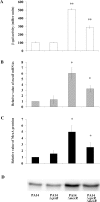CpxR Activates MexAB-OprM Efflux Pump Expression and Enhances Antibiotic Resistance in Both Laboratory and Clinical nalB-Type Isolates of Pseudomonas aeruginosa
- PMID: 27736975
- PMCID: PMC5063474
- DOI: 10.1371/journal.ppat.1005932
CpxR Activates MexAB-OprM Efflux Pump Expression and Enhances Antibiotic Resistance in Both Laboratory and Clinical nalB-Type Isolates of Pseudomonas aeruginosa
Abstract
Resistance-Nodulation-Division (RND) efflux pumps are responsible for multidrug resistance in Pseudomonas aeruginosa. In this study, we demonstrate that CpxR, previously identified as a regulator of the cell envelope stress response in Escherichia coli, is directly involved in activation of expression of RND efflux pump MexAB-OprM in P. aeruginosa. A conserved CpxR binding site was identified upstream of the mexA promoter in all genome-sequenced P. aeruginosa strains. CpxR is required to enhance mexAB-oprM expression and drug resistance, in the absence of repressor MexR, in P. aeruginosa strains PA14. As defective mexR is a genetic trait associated with the clinical emergence of nalB-type multidrug resistance in P. aeruginosa during antibiotic treatment, we investigated the involvement of CpxR in regulating multidrug resistance among resistant isolates generated in the laboratory via antibiotic treatment and collected in clinical settings. CpxR is required to activate expression of mexAB-oprM and enhances drug resistance, in the absence or presence of MexR, in ofloxacin-cefsulodin-resistant isolates generated in the laboratory. Furthermore, CpxR was also important in the mexR-defective clinical isolates. The newly identified regulatory linkage between CpxR and the MexAB-OprM efflux pump highlights the presence of a complex regulatory network modulating multidrug resistance in P. aeruginosa.
Conflict of interest statement
The authors have declared that no competing interests exist.
Figures



References
-
- Schweizer HP. Efflux as a mechanism of resistance to antimicrobials in Pseudomonas aeruginosa and related bacteria: unanswered questions. Genet Mol Res. 2003; 2: 48–62. - PubMed
MeSH terms
Substances
LinkOut - more resources
Full Text Sources
Other Literature Sources
Medical
Research Materials

